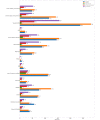Data Collection Mechanisms in Health and Wellness Apps: Review and Analysis
- PMID: 35262499
- PMCID: PMC8943537
- DOI: 10.2196/30468
Data Collection Mechanisms in Health and Wellness Apps: Review and Analysis
Abstract
Background: There has been a steady rise in the availability of health wearables and built-in smartphone sensors that can be used to collect health data reliably and conveniently from end users. Given the feature overlaps and user tendency to use several apps, these are important factors impacting user experience. However, there is limited work on analyzing the data collection aspect of mobile health (mHealth) apps.
Objective: This study aims to analyze what data mHealth apps across different categories usually collect from end users and how these data are collected. This information is important to guide the development of a common data model from current widely adopted apps. This will also inform what built-in sensors and wearables, a comprehensive mHealth platform should support.
Methods: In our empirical investigation of mHealth apps, we identified app categories listed in a curated mHealth app library, which was then used to explore the Google Play Store for health and medical apps that were then filtered using our selection criteria. We downloaded these apps from a mirror site hosting Android apps and analyzed them using a script that we developed around the popular AndroGuard tool. We analyzed the use of Bluetooth peripherals and built-in sensors to understand how a given app collects health data.
Results: We retrieved 3251 apps meeting our criteria, and our analysis showed that 10.74% (349/3251) of these apps requested Bluetooth access. We found that 50.9% (259/509) of the Bluetooth service universally unique identifiers to be known in these apps, with the remainder being vendor specific. The most common health-related Bluetooth Low Energy services using known universally unique identifiers were Heart Rate, Glucose, and Body Composition. App permissions showed the most used device module or sensor to be the camera (669/3251, 20.57%), closely followed by location (598/3251, 18.39%), with the highest occurrence in the staying healthy app category.
Conclusions: We found that not many health apps used built-in sensors or peripherals for collecting health data. The small number of the apps using Bluetooth, with an even smaller number of apps using standard Bluetooth Low Energy services, indicates a wider use of proprietary algorithms and custom services, which restrict the device use. The use of standard profiles could open this ecosystem further and could provide end users more options for apps. The relatively small proportion of apps using built-in sensors along with a high reliance on manual data entry suggests the need for more research into using sensors for data collection in health and fitness apps, which may be more desirable and improve end user experience.
Keywords: app analysis; app review; automation; data collection; data reliability; data sharing; development; mHealth; mHealth apps; mobile apps; mobile phone; usability; user experience.
©Ben Joseph Philip, Mohamed Abdelrazek, Alessio Bonti, Scott Barnett, John Grundy. Originally published in JMIR mHealth and uHealth (https://mhealth.jmir.org), 09.03.2022.
Conflict of interest statement
Conflicts of Interest: None declared.
Figures



Similar articles
-
Assessment of Mobile Health Apps Using Built-In Smartphone Sensors for Diagnosis and Treatment: Systematic Survey of Apps Listed in International Curated Health App Libraries.JMIR Mhealth Uhealth. 2020 Feb 3;8(2):e16741. doi: 10.2196/16741. JMIR Mhealth Uhealth. 2020. PMID: 32012102 Free PMC article.
-
Exploring Heart Disease-Related mHealth Apps in India: Systematic Search in App Stores and Metadata Analysis.J Med Internet Res. 2025 Mar 10;27:e53823. doi: 10.2196/53823. J Med Internet Res. 2025. PMID: 40063078 Free PMC article.
-
Tracing the Potential Flow of Consumer Data: A Network Analysis of Prominent Health and Fitness Apps.J Med Internet Res. 2017 Jun 28;19(6):e233. doi: 10.2196/jmir.7347. J Med Internet Res. 2017. PMID: 28659254 Free PMC article.
-
Privacy, Data Sharing, and Data Security Policies of Women's mHealth Apps: Scoping Review and Content Analysis.JMIR Mhealth Uhealth. 2022 May 6;10(5):e33735. doi: 10.2196/33735. JMIR Mhealth Uhealth. 2022. PMID: 35522465 Free PMC article.
-
mHealth Solutions for Perinatal Mental Health: Scoping Review and Appraisal Following the mHealth Index and Navigation Database Framework.JMIR Mhealth Uhealth. 2022 Jan 17;10(1):e30724. doi: 10.2196/30724. JMIR Mhealth Uhealth. 2022. PMID: 35037894 Free PMC article.
Cited by
-
Understanding citizens' attitudes within user-centered digital health ecosystems: A sequential mixed method methodology including a web-survey.Digit Health. 2024 May 20;10:20552076241255929. doi: 10.1177/20552076241255929. eCollection 2024 Jan-Dec. Digit Health. 2024. PMID: 39314816 Free PMC article.
-
Mobile Health Interventions: A Frontier for Mitigating the Global Burden of Cardiovascular Disease.Cureus. 2024 Jun 11;16(6):e62157. doi: 10.7759/cureus.62157. eCollection 2024 Jun. Cureus. 2024. PMID: 38993461 Free PMC article. Review.
-
Willingness of Participation in an Application-Based Digital Data Collection among Different Social Groups and Smartphone User Clusters.Sensors (Basel). 2023 May 8;23(9):4571. doi: 10.3390/s23094571. Sensors (Basel). 2023. PMID: 37177775 Free PMC article.
-
Prospective acceptability of digital phenotyping among pregnant and parenting people with opioid use disorder: A multisite qualitative study.Front Psychiatry. 2023 Apr 17;14:1137071. doi: 10.3389/fpsyt.2023.1137071. eCollection 2023. Front Psychiatry. 2023. PMID: 37139320 Free PMC article.
-
Participant Contributions to Person-Generated Health Data Research Using Mobile Devices: Scoping Review.J Med Internet Res. 2025 Jan 20;27:e51955. doi: 10.2196/51955. J Med Internet Res. 2025. PMID: 39832140 Free PMC article.
References
-
- World Health Organization . MHealth: New Horizons for Health Through Mobile Technologies. Geneva: World Health Organization; 2011.
-
- Mosa AS, Yoo I, Sheets L. A systematic review of healthcare applications for smartphones. BMC Med Inform Decis Mak. 2012 Jul 10;12:67. doi: 10.1186/1472-6947-12-67. https://bmcmedinformdecismak.biomedcentral.com/articles/10.1186/1472-694... 1472-6947-12-67 - DOI - DOI - PMC - PubMed
-
- Yusuf A, Zulkifli FY, Mustika IW. Development of monitoring and health service information system to support smart health on android platform. Proceedings of the 2018 4th International Conference on Nano Electronics Research and Education (ICNERE); 2018 4th International Conference on Nano Electronics Research and Education (ICNERE); Nov 27-29, 2018; Hamamatsu, Japan. 2018. - DOI
Publication types
MeSH terms
LinkOut - more resources
Full Text Sources
Medical

